Detailed Analysis of Corporate Governance Practices at API Limited
VerifiedAdded on 2020/04/07
|6
|1512
|322
Report
AI Summary
This report provides a comprehensive analysis of corporate governance at Australian Pharmaceutical Industries Limited (API Limited). It examines the company's governance structure, including the roles and responsibilities of the board of directors, and the committees established for risk and audit, remuneration, and nomination. The report highlights the importance of corporate governance in enhancing transparency and accountability, and its impact on stakeholders such as customers, shareholders, and the government. It also details API's compliance with ASX rules and its internal control practices, including financial and operational risk management. Furthermore, the report addresses frequently asked questions related to shareholding and company information, such as share price inquiries and contact details for shareholders. The analysis draws on API's annual reports and relevant literature to provide a holistic view of the company's corporate governance framework and its significance in the financial sector.
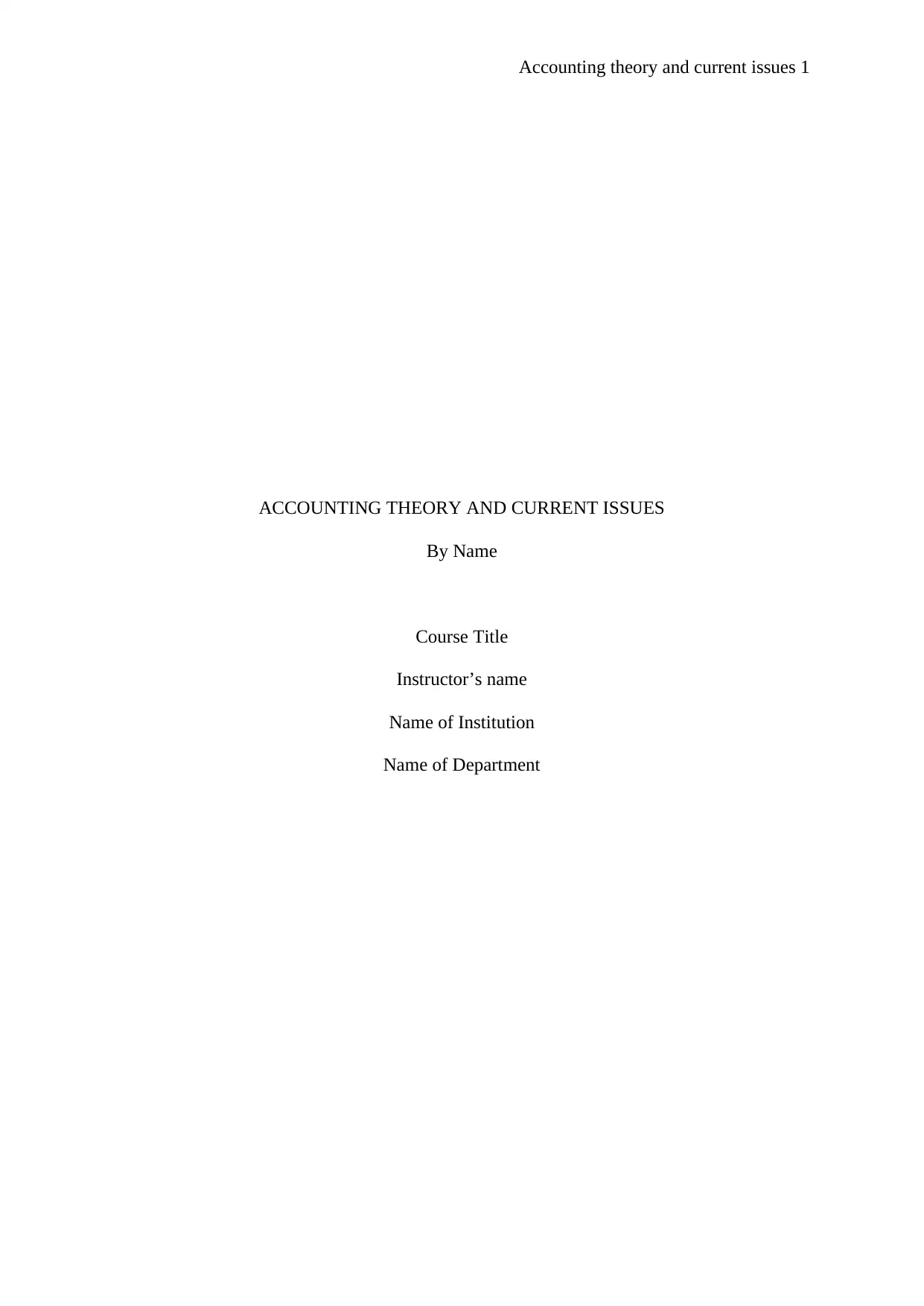
Accounting theory and current issues 1
ACCOUNTING THEORY AND CURRENT ISSUES
By Name
Course Title
Instructor’s name
Name of Institution
Name of Department
ACCOUNTING THEORY AND CURRENT ISSUES
By Name
Course Title
Instructor’s name
Name of Institution
Name of Department
Paraphrase This Document
Need a fresh take? Get an instant paraphrase of this document with our AI Paraphraser
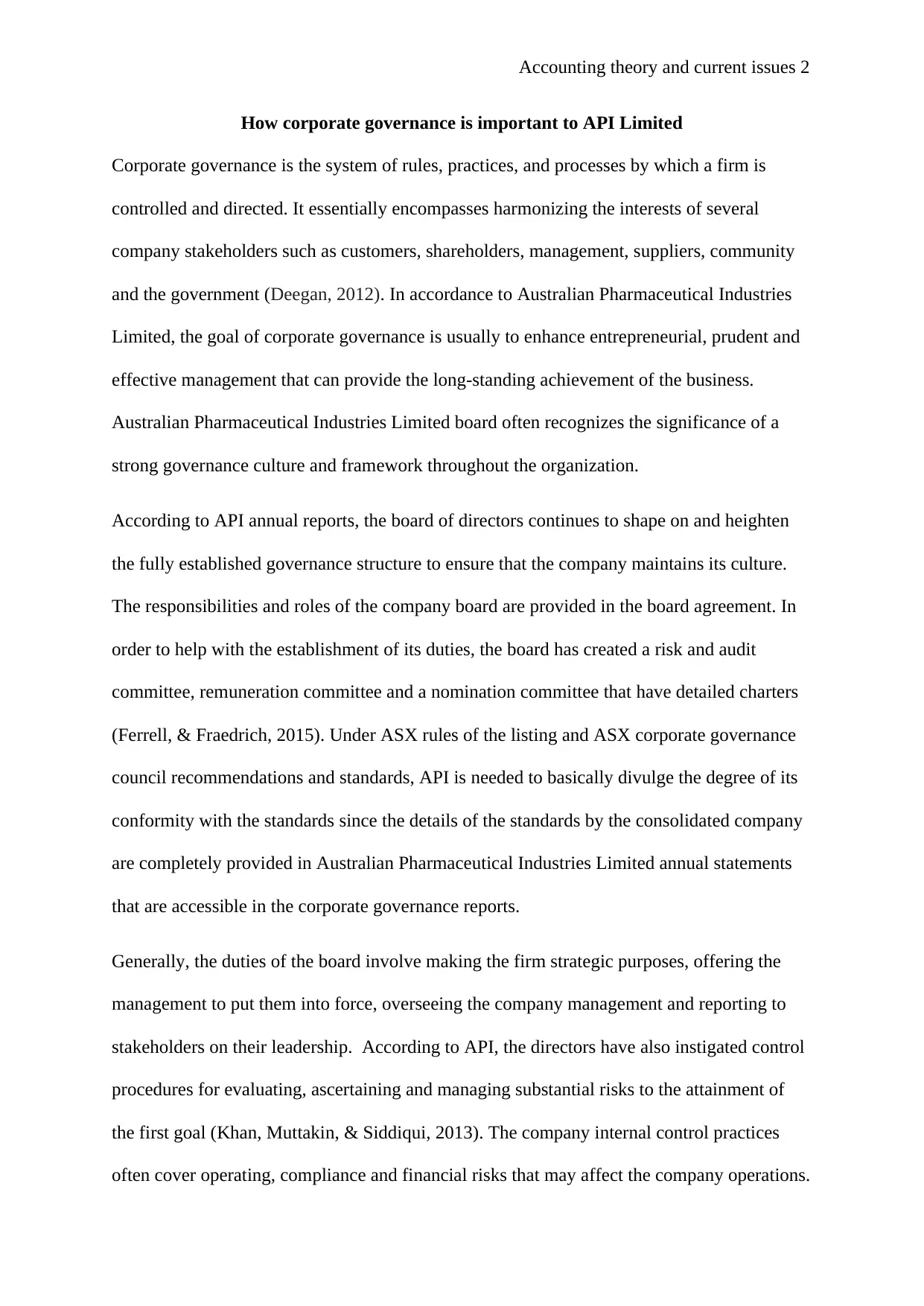
Accounting theory and current issues 2
How corporate governance is important to API Limited
Corporate governance is the system of rules, practices, and processes by which a firm is
controlled and directed. It essentially encompasses harmonizing the interests of several
company stakeholders such as customers, shareholders, management, suppliers, community
and the government (Deegan, 2012). In accordance to Australian Pharmaceutical Industries
Limited, the goal of corporate governance is usually to enhance entrepreneurial, prudent and
effective management that can provide the long-standing achievement of the business.
Australian Pharmaceutical Industries Limited board often recognizes the significance of a
strong governance culture and framework throughout the organization.
According to API annual reports, the board of directors continues to shape on and heighten
the fully established governance structure to ensure that the company maintains its culture.
The responsibilities and roles of the company board are provided in the board agreement. In
order to help with the establishment of its duties, the board has created a risk and audit
committee, remuneration committee and a nomination committee that have detailed charters
(Ferrell, & Fraedrich, 2015). Under ASX rules of the listing and ASX corporate governance
council recommendations and standards, API is needed to basically divulge the degree of its
conformity with the standards since the details of the standards by the consolidated company
are completely provided in Australian Pharmaceutical Industries Limited annual statements
that are accessible in the corporate governance reports.
Generally, the duties of the board involve making the firm strategic purposes, offering the
management to put them into force, overseeing the company management and reporting to
stakeholders on their leadership. According to API, the directors have also instigated control
procedures for evaluating, ascertaining and managing substantial risks to the attainment of
the first goal (Khan, Muttakin, & Siddiqui, 2013). The company internal control practices
often cover operating, compliance and financial risks that may affect the company operations.
How corporate governance is important to API Limited
Corporate governance is the system of rules, practices, and processes by which a firm is
controlled and directed. It essentially encompasses harmonizing the interests of several
company stakeholders such as customers, shareholders, management, suppliers, community
and the government (Deegan, 2012). In accordance to Australian Pharmaceutical Industries
Limited, the goal of corporate governance is usually to enhance entrepreneurial, prudent and
effective management that can provide the long-standing achievement of the business.
Australian Pharmaceutical Industries Limited board often recognizes the significance of a
strong governance culture and framework throughout the organization.
According to API annual reports, the board of directors continues to shape on and heighten
the fully established governance structure to ensure that the company maintains its culture.
The responsibilities and roles of the company board are provided in the board agreement. In
order to help with the establishment of its duties, the board has created a risk and audit
committee, remuneration committee and a nomination committee that have detailed charters
(Ferrell, & Fraedrich, 2015). Under ASX rules of the listing and ASX corporate governance
council recommendations and standards, API is needed to basically divulge the degree of its
conformity with the standards since the details of the standards by the consolidated company
are completely provided in Australian Pharmaceutical Industries Limited annual statements
that are accessible in the corporate governance reports.
Generally, the duties of the board involve making the firm strategic purposes, offering the
management to put them into force, overseeing the company management and reporting to
stakeholders on their leadership. According to API, the directors have also instigated control
procedures for evaluating, ascertaining and managing substantial risks to the attainment of
the first goal (Khan, Muttakin, & Siddiqui, 2013). The company internal control practices
often cover operating, compliance and financial risks that may affect the company operations.
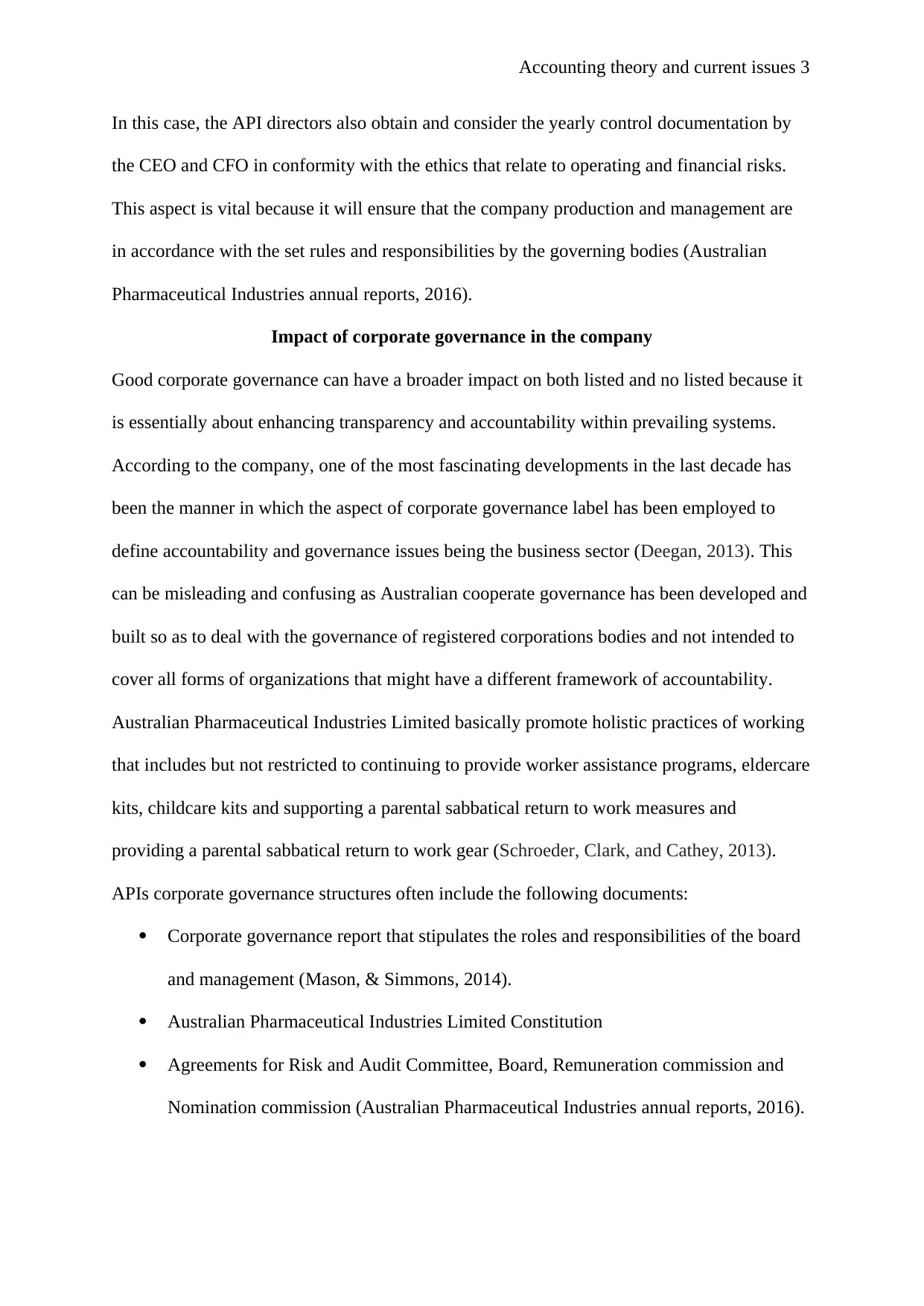
Accounting theory and current issues 3
In this case, the API directors also obtain and consider the yearly control documentation by
the CEO and CFO in conformity with the ethics that relate to operating and financial risks.
This aspect is vital because it will ensure that the company production and management are
in accordance with the set rules and responsibilities by the governing bodies (Australian
Pharmaceutical Industries annual reports, 2016).
Impact of corporate governance in the company
Good corporate governance can have a broader impact on both listed and no listed because it
is essentially about enhancing transparency and accountability within prevailing systems.
According to the company, one of the most fascinating developments in the last decade has
been the manner in which the aspect of corporate governance label has been employed to
define accountability and governance issues being the business sector (Deegan, 2013). This
can be misleading and confusing as Australian cooperate governance has been developed and
built so as to deal with the governance of registered corporations bodies and not intended to
cover all forms of organizations that might have a different framework of accountability.
Australian Pharmaceutical Industries Limited basically promote holistic practices of working
that includes but not restricted to continuing to provide worker assistance programs, eldercare
kits, childcare kits and supporting a parental sabbatical return to work measures and
providing a parental sabbatical return to work gear (Schroeder, Clark, and Cathey, 2013).
APIs corporate governance structures often include the following documents:
Corporate governance report that stipulates the roles and responsibilities of the board
and management (Mason, & Simmons, 2014).
Australian Pharmaceutical Industries Limited Constitution
Agreements for Risk and Audit Committee, Board, Remuneration commission and
Nomination commission (Australian Pharmaceutical Industries annual reports, 2016).
In this case, the API directors also obtain and consider the yearly control documentation by
the CEO and CFO in conformity with the ethics that relate to operating and financial risks.
This aspect is vital because it will ensure that the company production and management are
in accordance with the set rules and responsibilities by the governing bodies (Australian
Pharmaceutical Industries annual reports, 2016).
Impact of corporate governance in the company
Good corporate governance can have a broader impact on both listed and no listed because it
is essentially about enhancing transparency and accountability within prevailing systems.
According to the company, one of the most fascinating developments in the last decade has
been the manner in which the aspect of corporate governance label has been employed to
define accountability and governance issues being the business sector (Deegan, 2013). This
can be misleading and confusing as Australian cooperate governance has been developed and
built so as to deal with the governance of registered corporations bodies and not intended to
cover all forms of organizations that might have a different framework of accountability.
Australian Pharmaceutical Industries Limited basically promote holistic practices of working
that includes but not restricted to continuing to provide worker assistance programs, eldercare
kits, childcare kits and supporting a parental sabbatical return to work measures and
providing a parental sabbatical return to work gear (Schroeder, Clark, and Cathey, 2013).
APIs corporate governance structures often include the following documents:
Corporate governance report that stipulates the roles and responsibilities of the board
and management (Mason, & Simmons, 2014).
Australian Pharmaceutical Industries Limited Constitution
Agreements for Risk and Audit Committee, Board, Remuneration commission and
Nomination commission (Australian Pharmaceutical Industries annual reports, 2016).
⊘ This is a preview!⊘
Do you want full access?
Subscribe today to unlock all pages.

Trusted by 1+ million students worldwide
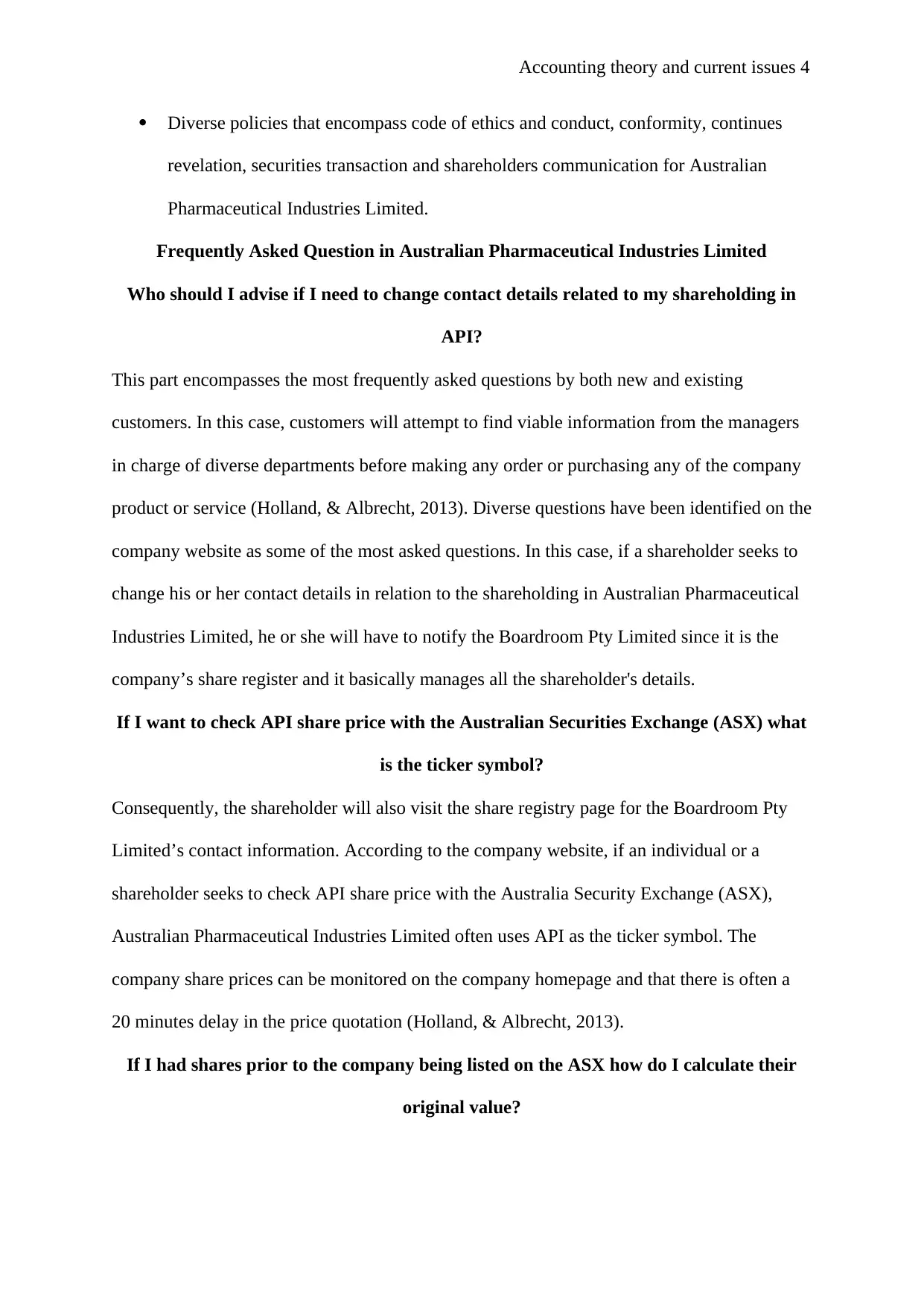
Accounting theory and current issues 4
Diverse policies that encompass code of ethics and conduct, conformity, continues
revelation, securities transaction and shareholders communication for Australian
Pharmaceutical Industries Limited.
Frequently Asked Question in Australian Pharmaceutical Industries Limited
Who should I advise if I need to change contact details related to my shareholding in
API?
This part encompasses the most frequently asked questions by both new and existing
customers. In this case, customers will attempt to find viable information from the managers
in charge of diverse departments before making any order or purchasing any of the company
product or service (Holland, & Albrecht, 2013). Diverse questions have been identified on the
company website as some of the most asked questions. In this case, if a shareholder seeks to
change his or her contact details in relation to the shareholding in Australian Pharmaceutical
Industries Limited, he or she will have to notify the Boardroom Pty Limited since it is the
company’s share register and it basically manages all the shareholder's details.
If I want to check API share price with the Australian Securities Exchange (ASX) what
is the ticker symbol?
Consequently, the shareholder will also visit the share registry page for the Boardroom Pty
Limited’s contact information. According to the company website, if an individual or a
shareholder seeks to check API share price with the Australia Security Exchange (ASX),
Australian Pharmaceutical Industries Limited often uses API as the ticker symbol. The
company share prices can be monitored on the company homepage and that there is often a
20 minutes delay in the price quotation (Holland, & Albrecht, 2013).
If I had shares prior to the company being listed on the ASX how do I calculate their
original value?
Diverse policies that encompass code of ethics and conduct, conformity, continues
revelation, securities transaction and shareholders communication for Australian
Pharmaceutical Industries Limited.
Frequently Asked Question in Australian Pharmaceutical Industries Limited
Who should I advise if I need to change contact details related to my shareholding in
API?
This part encompasses the most frequently asked questions by both new and existing
customers. In this case, customers will attempt to find viable information from the managers
in charge of diverse departments before making any order or purchasing any of the company
product or service (Holland, & Albrecht, 2013). Diverse questions have been identified on the
company website as some of the most asked questions. In this case, if a shareholder seeks to
change his or her contact details in relation to the shareholding in Australian Pharmaceutical
Industries Limited, he or she will have to notify the Boardroom Pty Limited since it is the
company’s share register and it basically manages all the shareholder's details.
If I want to check API share price with the Australian Securities Exchange (ASX) what
is the ticker symbol?
Consequently, the shareholder will also visit the share registry page for the Boardroom Pty
Limited’s contact information. According to the company website, if an individual or a
shareholder seeks to check API share price with the Australia Security Exchange (ASX),
Australian Pharmaceutical Industries Limited often uses API as the ticker symbol. The
company share prices can be monitored on the company homepage and that there is often a
20 minutes delay in the price quotation (Holland, & Albrecht, 2013).
If I had shares prior to the company being listed on the ASX how do I calculate their
original value?
Paraphrase This Document
Need a fresh take? Get an instant paraphrase of this document with our AI Paraphraser
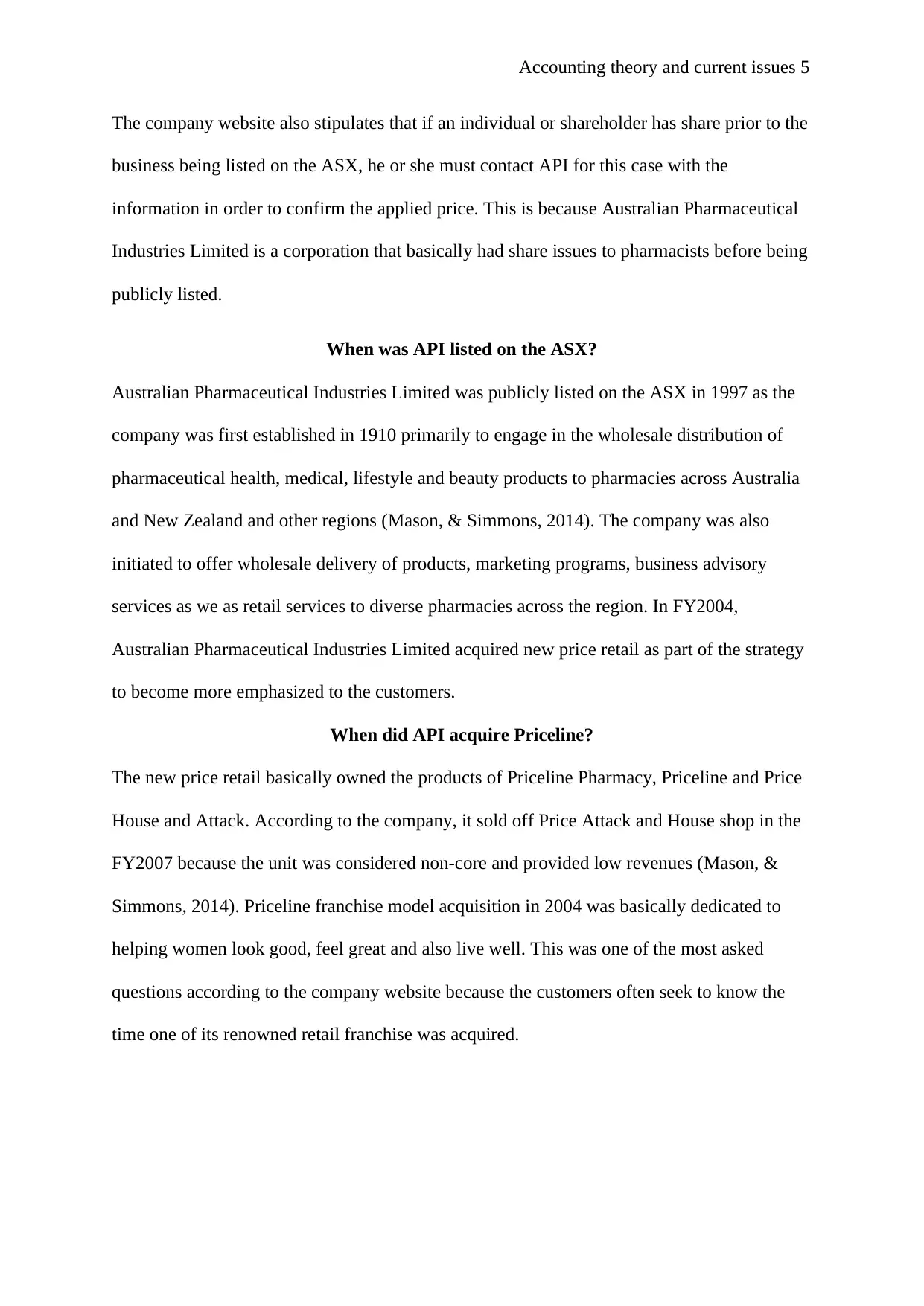
Accounting theory and current issues 5
The company website also stipulates that if an individual or shareholder has share prior to the
business being listed on the ASX, he or she must contact API for this case with the
information in order to confirm the applied price. This is because Australian Pharmaceutical
Industries Limited is a corporation that basically had share issues to pharmacists before being
publicly listed.
When was API listed on the ASX?
Australian Pharmaceutical Industries Limited was publicly listed on the ASX in 1997 as the
company was first established in 1910 primarily to engage in the wholesale distribution of
pharmaceutical health, medical, lifestyle and beauty products to pharmacies across Australia
and New Zealand and other regions (Mason, & Simmons, 2014). The company was also
initiated to offer wholesale delivery of products, marketing programs, business advisory
services as we as retail services to diverse pharmacies across the region. In FY2004,
Australian Pharmaceutical Industries Limited acquired new price retail as part of the strategy
to become more emphasized to the customers.
When did API acquire Priceline?
The new price retail basically owned the products of Priceline Pharmacy, Priceline and Price
House and Attack. According to the company, it sold off Price Attack and House shop in the
FY2007 because the unit was considered non-core and provided low revenues (Mason, &
Simmons, 2014). Priceline franchise model acquisition in 2004 was basically dedicated to
helping women look good, feel great and also live well. This was one of the most asked
questions according to the company website because the customers often seek to know the
time one of its renowned retail franchise was acquired.
The company website also stipulates that if an individual or shareholder has share prior to the
business being listed on the ASX, he or she must contact API for this case with the
information in order to confirm the applied price. This is because Australian Pharmaceutical
Industries Limited is a corporation that basically had share issues to pharmacists before being
publicly listed.
When was API listed on the ASX?
Australian Pharmaceutical Industries Limited was publicly listed on the ASX in 1997 as the
company was first established in 1910 primarily to engage in the wholesale distribution of
pharmaceutical health, medical, lifestyle and beauty products to pharmacies across Australia
and New Zealand and other regions (Mason, & Simmons, 2014). The company was also
initiated to offer wholesale delivery of products, marketing programs, business advisory
services as we as retail services to diverse pharmacies across the region. In FY2004,
Australian Pharmaceutical Industries Limited acquired new price retail as part of the strategy
to become more emphasized to the customers.
When did API acquire Priceline?
The new price retail basically owned the products of Priceline Pharmacy, Priceline and Price
House and Attack. According to the company, it sold off Price Attack and House shop in the
FY2007 because the unit was considered non-core and provided low revenues (Mason, &
Simmons, 2014). Priceline franchise model acquisition in 2004 was basically dedicated to
helping women look good, feel great and also live well. This was one of the most asked
questions according to the company website because the customers often seek to know the
time one of its renowned retail franchise was acquired.
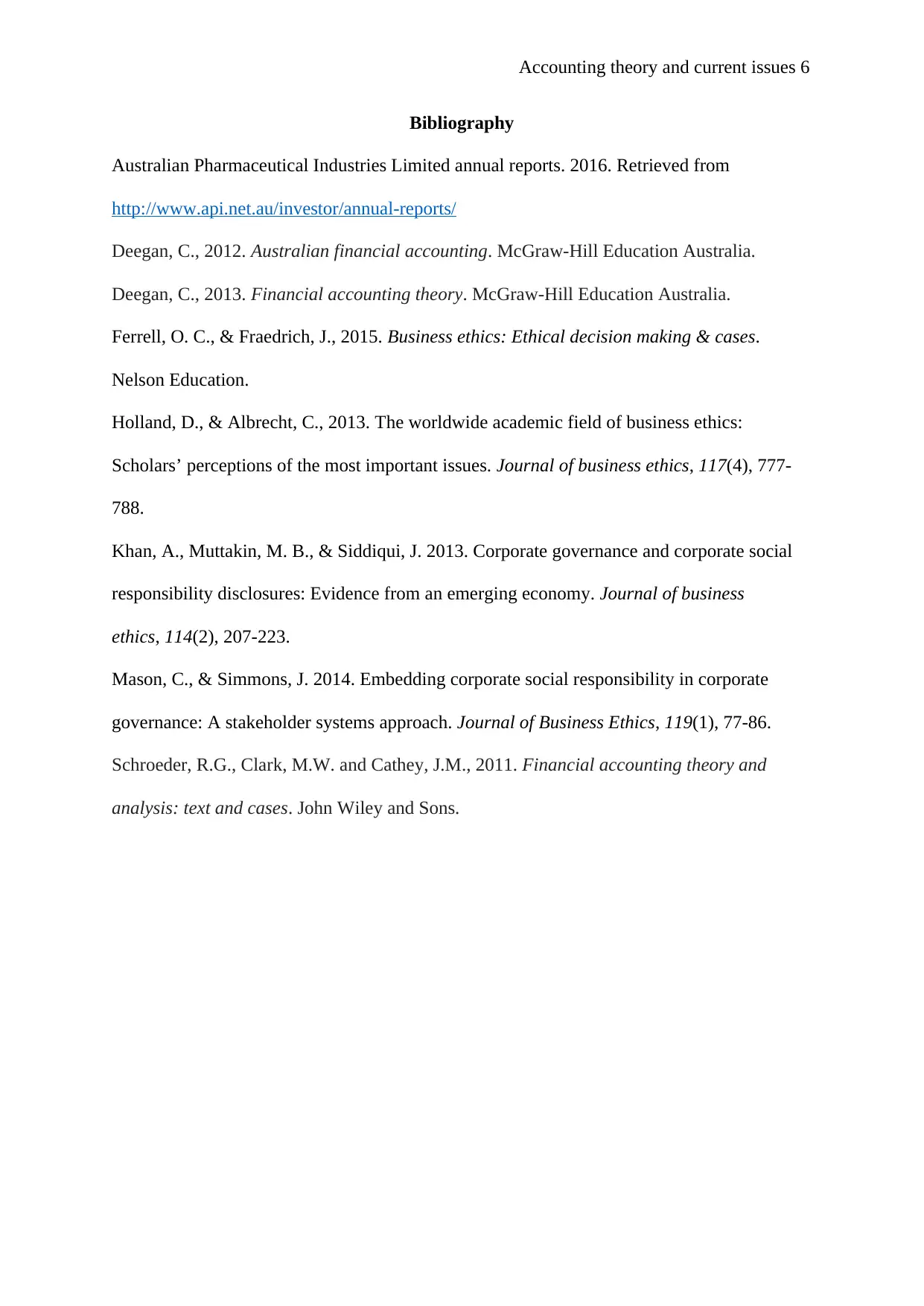
Accounting theory and current issues 6
Bibliography
Australian Pharmaceutical Industries Limited annual reports. 2016. Retrieved from
http://www.api.net.au/investor/annual-reports/
Deegan, C., 2012. Australian financial accounting. McGraw-Hill Education Australia.
Deegan, C., 2013. Financial accounting theory. McGraw-Hill Education Australia.
Ferrell, O. C., & Fraedrich, J., 2015. Business ethics: Ethical decision making & cases.
Nelson Education.
Holland, D., & Albrecht, C., 2013. The worldwide academic field of business ethics:
Scholars’ perceptions of the most important issues. Journal of business ethics, 117(4), 777-
788.
Khan, A., Muttakin, M. B., & Siddiqui, J. 2013. Corporate governance and corporate social
responsibility disclosures: Evidence from an emerging economy. Journal of business
ethics, 114(2), 207-223.
Mason, C., & Simmons, J. 2014. Embedding corporate social responsibility in corporate
governance: A stakeholder systems approach. Journal of Business Ethics, 119(1), 77-86.
Schroeder, R.G., Clark, M.W. and Cathey, J.M., 2011. Financial accounting theory and
analysis: text and cases. John Wiley and Sons.
Bibliography
Australian Pharmaceutical Industries Limited annual reports. 2016. Retrieved from
http://www.api.net.au/investor/annual-reports/
Deegan, C., 2012. Australian financial accounting. McGraw-Hill Education Australia.
Deegan, C., 2013. Financial accounting theory. McGraw-Hill Education Australia.
Ferrell, O. C., & Fraedrich, J., 2015. Business ethics: Ethical decision making & cases.
Nelson Education.
Holland, D., & Albrecht, C., 2013. The worldwide academic field of business ethics:
Scholars’ perceptions of the most important issues. Journal of business ethics, 117(4), 777-
788.
Khan, A., Muttakin, M. B., & Siddiqui, J. 2013. Corporate governance and corporate social
responsibility disclosures: Evidence from an emerging economy. Journal of business
ethics, 114(2), 207-223.
Mason, C., & Simmons, J. 2014. Embedding corporate social responsibility in corporate
governance: A stakeholder systems approach. Journal of Business Ethics, 119(1), 77-86.
Schroeder, R.G., Clark, M.W. and Cathey, J.M., 2011. Financial accounting theory and
analysis: text and cases. John Wiley and Sons.
⊘ This is a preview!⊘
Do you want full access?
Subscribe today to unlock all pages.

Trusted by 1+ million students worldwide
1 out of 6
Related Documents
Your All-in-One AI-Powered Toolkit for Academic Success.
+13062052269
info@desklib.com
Available 24*7 on WhatsApp / Email
![[object Object]](/_next/static/media/star-bottom.7253800d.svg)
Unlock your academic potential
Copyright © 2020–2025 A2Z Services. All Rights Reserved. Developed and managed by ZUCOL.





